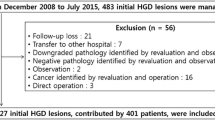Abstract
Background/Aim
The standard treatment for patients with gastric low-grade dysplasia (LGD) remains controversial, even though diagnosis of LGD is increasingly common as esophagogastrodeuodenoscopy becomes more available. The aim of this study was to identify a lesion size cut-off as an indication for endoscopic resection (ER) for patients with LGD.
Results
We retrospectively reviewed 285 lesions initially diagnosed as LGD by endoscopic forceps biopsies (EFB) from 2007 to 2010 in Kyung Hee University Hospital, Seoul, Korea. All patients underwent ER. A total of 285 lesions from 257 patients were assessed. After ER, 239 LGD (83.9 %) showed histological concordance and the remaining 46 (16.1 %) cases revealed an upgraded histology [22 high-grade dysplasia (7.7 %), and 24 differentiated adenocarcinoma (8.4 %)]. Univariate analyses demonstrated that lesion size, erythema, depression, and erosion were significant predictors of upgraded LGD (P < 0.001). Multivariate analysis showed that a lesion size ≥2 cm, erythema, and a depressed-type lesion were independent predictors of upgraded histology (P = 0.014, odds ratio 3.27, 95 % confidence interval 1.28–8.39).
Conclusions
Our data suggest that a substantial number of LGD diagnoses based on EFB were not representative of the entire lesion. We recommend ER if gastric LGD has at least one of the following risk factors: surface erythema and a depressed type regardless of size, or ≥2 cm size regardless of abnormal surface configuration.

Similar content being viewed by others
References
Shin HR, Won YJ, Jung KW, et al. Nationwide cancer incidence in Korea, 1999–2001; first result using the national cancer incidence database. Cancer Res Treat. 2005;37:325–331.
Ming SC, Bajtai A, Correa P, et al. Gastric dysplasia. Significance and pathologic criteria. Cancer. 1984;54:1794–1801.
Morson BC, Sobin LH, Grundmann E, Johansen A, Nagayo T, Serck-Hanssen A. Precancerous conditions and epithelial dysplasia in the stomach. J Clin Pathol. 1980;33:711–721.
Dinis-Ribeiro M, Areia M, de Vries AC, et al. Management of precancerous conditions and lesions in the stomach (MAPS): guideline from the European Society of Gastrointestinal Endoscopy (ESGE), European Helicobacter Study Group (EHSG), European Society of Pathology (ESP), and the Sociedade Portuguesa de Endoscopia Digestiva (SPED). Endoscopy. 2012;44:74–94.
Jeon SW. Endoscopic management of gastric dysplasia: cutting edge technology needs a new paradigm. World J Gastrointest Endosc. 2010;2:301–304.
Dixon MF. Gastrointestinal epithelial neoplasia: Vienna revisited. Gut. 2002;51:130–131.
Di Gregorio C, Morandi P, Fante R, De Gaetani C. Gastric dysplasia. A follow-up study. Am J Gastroenterol. 1993;88:1714–1719.
Rugge M, Farinati F, Baffa R, et al. Gastric epithelial dysplasia in the natural history of gastric cancer: a multicenter prospective follow-up study. Interdisciplinary Group on Gastric Epithelial Dysplasia. Gastroenterology. 1994;107:1288–1296.
Park DI, Rhee PL, Kim JE, et al. Risk factors suggesting malignant transformation of gastric adenoma: univariate and multivariate analysis. Endoscopy. 2001;33:501–506.
Cho SJ, Choi IJ, Kim CG, et al. Risk of high-grade dysplasia or carcinoma in gastric biopsy-proven low-grade dysplasia: an analysis using the Vienna classification. Endoscopy. 2011;43:465–471.
Kim YJ, Park JC, Kim JH, et al. Histologic diagnosis based on forceps biopsy is not adequate for determining endoscopic treatment of gastric adenomatous lesions. Endoscopy. 2010;42:620–626.
Lee SB, Kang HY, Kim KI, Ahn DH. The diagnostic accuracy of endoscopic biopsy for gastric dysplasia. J Gastric Cancer. 2010;10:175–181.
Kim JH, Song KS, Youn YH, et al. Clinicopathologic factors influence accurate endosonographic assessment for early gastric cancer. Gastrointest Endosc. 2007;66:901–908.
Correa P, Houghton J. Carcinogenesis of Helicobacter pylori. Gastroenterology. 2007;133:659–672.
Kimura K, Takemoto T. An endoscopic recognition of the atrophic border and its significance in chronic gastritis. Endoscopy. 1969;1:87–96.
Endoscopic Classification Review Group. Update on the Paris classification of superficial neoplastic lesions in the digestive tract. Endoscopy. 2005;37:570–578.
Schlemper RJ, Riddell RH, Kato Y, et al. The Vienna classification of gastrointestinal epithelial neoplasia. Gut. 2000;47:251–255.
Yeh JM, Hur C, Kuntz KM, Ezzati M, Goldie SJ. Cost-effectiveness of treatment and endoscopic surveillance of precancerous lesions to prevent gastric cancer. Cancer. 2010;116:2941–2953.
Lauwers GY, Srivastava A. Gastric preneoplastic lesions and epithelial dysplasia. Gastroenterol Clin North Am. 2007;36:813–829, vi.
Yamada H, Ikegami M, Shimoda T, Takagi N, Maruyama M. Long-term follow-up study of gastric adenoma/dysplasia. Endoscopy. 2004;36:390–396.
Gowen GF. Endoscopic biopsy for improved accuracy in upper gastrointestinal tract diagnosis. Arch Surg. 1982;117:485–489.
Remmele W, Kolb EF. Malignant transformation of hyperplasiogenic polyps of the stomach—case report. Endoscopy. 1978;10:63–65.
Ginsberg GG, Al-Kawas FH, Fleischer DE, Reilly HF, Benjamin SB. Gastric polyps: relationship of size and histology to cancer risk. Am J Gastroenterol. 1996;91:714–717.
Muehldorfer SM, Stolte M, Martus P, Hahn EG, Ell C. Multicenter Study Group “Gastric Polyps”. Diagnostic accuracy of forceps biopsy versus polypectomy for gastric polyps: a prospective multicentre study. Gut. 2002;50:465–470.
Mine T. The role of magnifying endoscopy in the diagnosis of early gastric carcinoma. J Gastroenterol. 2006;41:397–398.
Hirata I, Nakagawa Y, Ohkubo M, Yahagi N, Yao K. Usefulness of magnifying narrow-band imaging endoscopy for the diagnosis of gastric and colorectal lesions. Digestion. 2012;85:74–79.
Sabbagh LC, Reveiz L, Aponte D, de Aguiar S. Narrow-band imaging does not improve detection of colorectal polyps when compared to conventional colonoscopy: a randomized controlled trial and meta-analysis of published studies. BMC Gastroenterol. 2011;11:100–112.
Haber MM. Gastric biopsies: increasing the yield. Clin Gastroenterol Hepatol. 2007;5:160–165.
Levine DS, Reid BJ. Endoscopic biopsy technique for acquiring larger mucosal samples. Gastrointest Endosc. 1991;37:332–337.
Rugge M, Cassaro M, Di Mario F, et al. The long term outcome of gastric non-invasive neoplasia. Gut. 2003;52:1111–1116.
Park SY, Jeon SW, Jung MK, et al. Long-term follow-up study of gastric intraepithelial neoplasias: progression from low-grade dysplasia to invasive carcinoma. Eur J Gastroenterol Hepatol. 2008;20:966–970.
Kim SY, Sung SK, Moon HS, et al. Is endoscopic mucosal resection a sufficient treatment for low-grade gastric epithelial dysplasia? Gut Liver. 2012;6:446–451.
Conflict of interest
None.
Author information
Authors and Affiliations
Corresponding author
Rights and permissions
About this article
Cite this article
Kim, M.K., Jang, J.Y., Kim, JW. et al. Is Lesion Size an Independent Indication for Endoscopic Resection of Biopsy-Proven Low-Grade Gastric Dysplasia?. Dig Dis Sci 59, 428–435 (2014). https://doi.org/10.1007/s10620-013-2805-8
Received:
Accepted:
Published:
Issue Date:
DOI: https://doi.org/10.1007/s10620-013-2805-8




